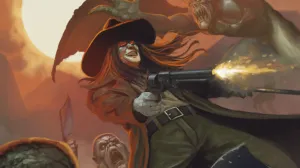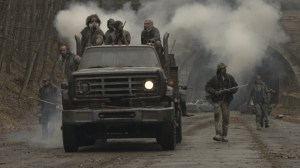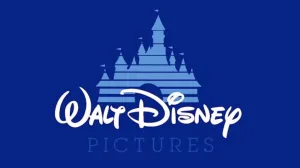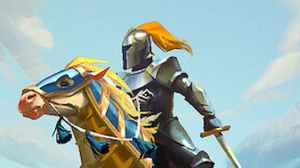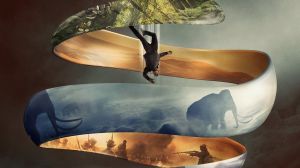Talking to screenwriter/producer Jeremy Slater is like one big, beautiful geek session. During a Zoom call, it’s easy to see his room littered with artwork and life-sized Star Wars statues such as R2-D2, but it’s his impressive resume that further speaks volumes. A comic book afficionado, Slater penned 2015’s Fantastic Four film and created the Moon Knight TV series. He also wrote and executive produced Netflix’s The Umbrella Academy. Slater has dipped into the horror genre with The Lazarus Effect movie and The Exorcist TV series. And he was initially attached to Coyote vs. Acme. As if all that wasn’t enough, Slater channelled his inner gamer for this fall’s Mortal Kombat II feature film.
Videos by ComicBook.com
While the filmmaker already has enough credits in his career to cement his legacy among genre fans, it sounds like the filmmaker is only just getting started.
ComicBook caught up with Slater to discuss the original blueprints for Coyote vs. Acme, his take on the Fantastic Four and where it derailed, cranking up the action for Mortal Kombat II, and Moon Knight’s second season.

ComicBook: Once upon a time, you were attached to Coyote vs. Acme. At what point in development did you come on board?
Jeremy Slater: I did the very first draft. Basically, what happened is James Gunn had the idea to take Ian Frazier’s one-page, short story from The New Yorker. James had pitched that to Warner Bros. and said, “Hey, you should actually turn this article into a movie. There is a story here.” I was friends with James, so he brought me on board to write the first draft. I had a blast doing it. I grew up on the Looney Tunes. Getting to write your own sequence … There’s a little bit of cartoon-stuff that in the movie that is classic Coyote chasing the Road Runner. Some of that is my only contribution that survived to the actual movie, but getting the chance to sit down and write your own Road Runner/Coyote cartoon and gags was surreal. It was so incredibly fun. I had a great time writing the script.
Then, we handed it in and it just wasn’t what they were looking for at that time. They didn’t respond to the script, which happens all the time and you go on with your life. Eight years later, they were like, “Guess what? They are making Coyote vs. Acme.” I was like, “Jeez, that thing is still alive?” “Yeah, it’s gone through a half-a-dozen different writers.” The final draft doesn’t have a lot of stuff from my draft, but they did a good job of capturing the spirit, emotion, and central relationships that were important to us right from the beginning. Those were all preserved in the new draft. I haven’t seen the actual movie itself. I had a chance to see it, but I had a conflict of interest. I thought, “I’ll probably just see it next week when it comes out,” and as you know, it never came out. I’m very excited to see the final product like everyone. I did get to read the shooting script and I thought Samy Burch did a terrific job rewriting it.
When James Gunn approached you about this concept, did it make sense to you? What is so compelling about Wile E. Coyote as the central figure in this narrative?
We bounced a lot of different versions around. We had a lot of conversations. I want to be careful to not take credit for something that wasn’t mine because this was 10 years ago. One thing, whether it was originated by James or whether it came out of my discussions with them, was there is a version of this story that is just a live-action cartoon. It treats everything as a gag. There have probably been some Looney Tunes movies in the past that have fallen in that category, that are much more gag focused. What we both creatively responded to was the idea of, “Let’s have the fun stuff. Let’s make this a movie for Looney Tunes fans, with all the comedy and the visual-sight gags that are expected. But, can we also add some heart to this? Can we actually make you care about the Coyote and fall in love with him, instead of just making him the butt of the jokes, which he always sort of is.”
He is a loveable loser in all the original cartoons, but both James and I are both big dog people. We are obsessed with our dogs. Especially in our first drafts, there was a lot of our story beats that came from that idea. You are telling a Looney Tunes story, but it’s still a story about the Coyote wanting to eat the Road Runner. But, at the same time, it really is a story about a man getting a dog for the first time and how it changes your life and how unexpected bonds form and you can fall in love of these scraggly little creatures. That was what was most exciting to me and to James, as well. I think they did a great job at preserving that level of heart.
Coyote doesn’t speak in the cartoons. Did he find his voice in your iteration?
In my draft, he didn’t speak at all. We treated him like a real coyote, who just happened to be smart enough to order and assemble gadgets, but we never had him break the fourth wall and speaking to anybody. We wanted him to feel like your dog back home. We wanted people to recognize their own pets in that character. As soon as he starts giving speeches or speaking in a British accent, that goes right out the window.
Coyote and Road Runner are front and center, but the Looney Tunes pantheon is full of colorful, iconic characters. Are there any other ones that you geeked out over writing for?
There are a lot of fun cameos in the final movie. I don’t want to spoil any of them. This was 10 years ago and there were other Looney Tunes projects back then that never wound up happening. And there were other projects that later happened that weren’t even in the conceptual phase back then. So, there was a little bit of, “You can have this character and this character. These ones are kind of off limits.” But we got to work the Tasmanian Devil into my script and use him as an antagonist, where he is just this terrifying force and once he gets unleashed, everyone is running for the hills.
It was a way to use Taz, who I love so much, as a fun new version, where he is a little bit like a honey badger. He is just this pure ball of aggression. I don’t know how much of that is in the final thing, but he was the one gimme where I was like, “I’m okay not having Bugs. I’m okay not having Daffy. Please let me play with Taz a little bit. We need a monster for this sequence of the movie.” And if you can have the Tasmanian Devil be that monster, why wouldn’t you?
This year marks the 10th anniversary of your 2015 Fantastic Four film. What do you love about that team?
Ben Grimm is in my top-five comic book characters. I am obsessed with The Thing. He was one of my favorites since I was a child. What I love about the Fantastic Four is they are so malleable. Every Daredevil story is kind of the same, to some degree. Every Superman story. Every Green Arrow story. Every Spider-Man story. Spider-Man is always acting like Spider-Man. He’s swinging around and fighting his colorful villains. If you look at the difference between Mark Waid and Matt Fraction’s run on Fantastic Four vs. Jonathan Hickman’s run on Fantastic Four. Ryan North, right now, his relaunch of Fantastic Four is brilliant. It’s some of the best comic book writing done, period, regardless of whether it is in the superhero genre.
But all three of them are radically different takes on how funny the characters are, how cool they are. Are they adventurers? Are they scientists? Are they cosmic explorers? Are they freaks? Are they family? They really are this blank canvas. You see it in comics and you see it in film. You see how different every iteration of this team has been. But because there is so much history there, and because the books are so creative and the characters are so much fun, I feel the characters are so much more flexible. You can take creative swings or reimagine them in a way that is much easier than reimagining Spider-Man.
Which comic book runs or issues inspired you when tackling the script?
At the time, I believe this was pre-Hickman, Mark Waid and John Byrne were my two big goal posts. Mark Waid, in particular, his second collection where Doom becomes a sorcerer, is f-cking great. That was a book I remember giving to director Josh Trank, who was not a comic book reader. “You are going to love this story because it is tinged with horror. It is emotional based. The artwork from Mike Wieringo.” It was just a perfect comic book. That was one of those early ones that I remember loaning him, my copy of that graphic novel and being like, “This is what Fantastic Four can be. It’s flexible enough that we can dabble in the worlds of horror. We can dabble in hard science fiction.” If I really have to tip my hat in terms of what became most influential, my guess would be that Mark Waid run.
Fans criticized the campiness of the first few Fantastic Four movies. What was your vision for the tone, the look, and the team itself?
Honestly, my biggest tonal reference was The Avengers. It had just come out, either that same summer or the summer before. I f-cking loved it. I thought Joss Whedon did the impossible with that movie and balanced all these tones. I still remember, in the theater, the first time Thor spun his hammer and used it to launch into the sky. It’s just a background gag and I made this uncontrollable squeak. It was just something from my childhood that I never thought I would see in live action.
I was like, “Look — audiences love this movie. The box-office numbers don’t lie.” I thought we could really do something similar in terms of real scale and some giant, fun set pieces. But, let’s also not forget the secret sauce of that movie, which is the relationships. It’s Natasha and calming down Bruce. And it’s Clint joining the team. It’s Cap and Tony butting heads. That’s the reason that movie works, is because you like the characters and them bouncing off each other. That was always the North Star. “Man, if we could do what Marvel is doing right now, this is clearly what audiences want to see in a comic book movie.”
Ultimately, that was fundamentally the disconnect. Josh and I probably just saw different movies. I was more of an Avengers guy and, I don’t want to put words in his mouth, but he was more of a Batman Begins, like ultra-grounded, dark and gritty guy. The comic book nature of something like The Avengers, that I had been absorbing and loving my entire life, he didn’t have those same touch points, so that movie wasn’t landing for him the way it landed for me. The other thing is Avengers was a very expensive movie. Our budget was constantly shrinking as the project kept going. It’s easy to say, “Yeah, let’s go do Avengers,” but it’s hard to actually do it. I think the script I was writing, and the movie I was seeing in my head, was much closer to that Phase 1 of what Avengers was doing at the time than it was anything else.
The trailer for the new Fantastic Four has been released. What were your thoughts on it and the direction it seems to be going in?
I’m excited. I like the fact that they are taking a big creative swing. They are telling a multiverse story, with a different world and a different set of heroes. It looks like they are bringing them in collision with our Marvel Cinematic Universe. I think that is a smart angle. I think they are getting Galactus right. I wanted to make him our big bad and there was some internal push back. First, he was our big bad. Then, he was just going to appear in one scene. Then, he was only appearing in the post-credits scene. Coming off the Galactus cloud from [2007’s Fantastic Four:] Rise of the Silver Surfer, which I was one of those fanboys probably bitching on Ain’t It Cool News back then about how he was a f-cking cloud, I was excited to bring back a classic Galactus and have that Jack Kirby design. It looked like they’ve accomplished that, so I can’t wait to see him in real life.
Next on your plate is Mortal Kombat II, which hits theaters this fall. What’s your history with the video game?
I’m a huge gamer and Mortal Kombat was one of those games where I had to beg my parents to buy me a Genesis. In the Genesis version, there is actual blood. And in the Super Nintendo version, when you punch people, white sweat flew off of them. I was like, “You have to have the blood.” I pumped so many damn quarters into that machine.
It was genuinely surreal. I wasn’t there for the filming, but I managed to go down to Australia last year. They did a couple of days of reshoots and, luckily, almost the whole cast was there in costume. Look through my phone and there’s pictures of me next to Raiden, Kitana, and Baraka. You always say, “If I could go back in time to that 13-year-old me, who is standing in that Pizza Hut with his roll of quarters, waiting to put his quarter down for the next game and be like, ‘Someday you are going to be taking pictures with the real-life versions of these characters and be a small part in bringing them to life…,’”
It’s a tremendous honor and incredibly cool. It was one of those days where you are just pinching yourself. “Wow, I just had a full conversation with Liu Kang, in his warrior robes.” Then, you watch him walk out and beat the ever-loving sh-t out of someone with the craziest moves you have ever seen.
I am so excited for people to see the movie. It’s been done for a while. We’ve been waiting for the right release date and waiting for the right window. I have been to those test screenings, which are full of Mortal Kombat fans, and watching them react to it the way I reacted to Avengers: Endgame. They were cheering and jumping out of their seats. Every joke is landing and they are loving it. It’s one of the greatest moments of my life. That’s why you get into this business.
What did you want to pull from the game for this sequel, but also bring to the narrative that was fresh?
The nice thing about a franchise like Mortal Kombat is you go into the arcade, put in your quarter, you choose a different character each time and you have a different adventure each time. In a lot of ways, Mortal Kombat lends itself to having new protagonists and new stories, in a way other franchises don’t. We came in with certain guide posts that were already in place.
The previous movie promised there was a tournament coming and that Johnny Cage was going to be part of the story, somehow. Those were the two things we knew we had to work with and around. I was adamant that we had to have this tournament in the movie. We can’t make people wait another movie and then be like, “Come back for the finale.” It was finding a structure to make the tournament as satisfying as you want it to be because this had years of build-up. It’s figuring out who the individual matches are going to be, which characters do you pair off for maximum emotional impact, but also for the most dynamic fights. Then, also, what is the larger story you are telling between the tournament.
A lot of kung-fu movies and martial-arts tournament movies, a lot of it is sitting around waiting. Then, there’s a big fight scene and then you go back to sitting around waiting. It’s killing time between stages and I was very cognizant of that, that we need to be telling a story on the margins where there is just as much exciting stuff happening outside of the tournament as inside of the tournament, so you are never bored and both of these stories are moving the movie forward.
Then, which are the characters that were serviced in the last movie and got a lot of screen time and probably had a completed arc and don’t need quite as much versus the characters coming in? It’s a cast of 20 people. It’s very easy for these things to become three-to-four-hour, sprawling epics, so you always have to be judicious in cutting things down and what’s the emotional story we are telling and what is the story the audience cares about. Then, making sure when you get to those moments that matter — the fights, the fatalities, the surprises, the deaths — that they land and they are as satisfying as everyone wants them to be. I think we nailed it. They had the best stunt team in the business working on this thing. The actors are phenomenal. It’s so much funnier and bigger than the first movie.
A big draw to Mortal Kombat are the fight sequences. When scripting those, do you map everything out or do you leave it up to the choreographers?
That’s a great question. The way I write fight scenes is if you sat down and tried to transcribe an actual martial-arts fight, it would be a page of, “He punches. She blocks. She kicks. He blocks.” Your eyes would glaze over. What we tried to do on the page is sell the emotional story and then sell the big beats.
I know in my head, “Here’s the big gags. Here’s the gore gags. Here’s the part where the audience thinks it is going to go this way and we are going to flip it on its head.” You track it out there and you come up with your own gags. Some of those gags that I came up with made it into the movie. Some of them are the process of them handing the two-pages of script off to the stunt team, and the stunt team start imagining. They start coming up with new ways of, “Oh, wouldn’t it be cool if this guy used his powers here. Maybe he bounces off this guy.” They wear their homemade costumes and they go into the warehouse full of boxes. They start building these fight scenes of them mining, “Here is what it could look like.”
I was lucky enough to watch the progression of those scenes and see how director Simon McQuoid would take these building blocks they were giving and see how they would refine them. “These parts are awesome. We are keeping this. We need a little bit more here.” Each time the stunt guys would just come back with something bigger and crazier. The stuff that was on the page I was proud of, but the stuff that is in the finished movie is so much better, and so much better and more epic than what I came up with.
Actor Lewis Tan, who portrays Cole Young, excels at martial artist and there are other cast members that are well-versed in that department. Do you take that into consideration when writing scenes?
I didn’t have to do much. So much of the groundwork was laid by Simon and the casting that was done on the first movie. Guys like Lewis, Ludi Lin, who plays Liu Kang and Max Huang, who plays Kung Lao, they are actually world-class martial artists. They are the best of the best and they can also act. And they are really nice guys and embody their characters. It freed me up in the sense that I didn’t have to go, “Oh, this guy can fight, but he can’t act. This guy can act, but he can’t fight.” It was a group that could do everything. That’s really freeing as a writer because it lets you write the best story for those characters and for those moments. You just trust that a guy like Lewis is talented enough to pull off whatever you need him to do … and he always was. That guy is awesome.
Circling back to superheroes, any update on a second season for the Moon Knight TV series?
Oh, God, I have no idea. If we do, I probably would not be involved. I am trying to launch my directing career. I am hoping to shoot in August. We are out to an Oscar-winning actor right now and waiting on his response, so it’s very exciting. TV takes you off the board for two or three years. If there is another Moon Knight, the ball is in Kevin Feige and Oscar Isaac’s court. I don’t know the details of their contract. Once Kevin figures out the best way to use that character, what is the right story and who are the right storytellers to bring that to life, I would be shocked if we didn’t see him again at some point. But, that’s me speculating as a fan. I have no inside knowledge. I haven’t talked to anyone at marvel in a couple of years.
Was there anything you didn’t get to do with the character?
The finished show is very different than the initial show I wrote. There was quite a bit that me and my team of writers envisioned and tried to bring to life. Ultimately, they went in a different direction and the director put together his own team of writers. They made the show they wanted to make and I was long gone from the project at that point. So, yeah, there was definitely stories I wanted to tell, but that’s the nature of collaborating on these big things.
You know when you are coming in to play in such a big sandbox that you are not going to be the driving, creative vision. You are borrowing someone else’s toys to play with for a short amount of time and, at the end of the day, they don’t belong to you. You know that going in, so it wasn’t a surprise at all, but I think my version of Moon Knight would have certainly been different, but I don’t know if it would have been better or worse. I don’t know if the fans would have liked it more or less. It’s one of those hypotheticals that is never going to exist.
Can you name a specific story that you wanted to tell?
This wasn’t something that came about because of the turnover, this was something we just couldn’t figure out in the room, but we really tried to make Bushman work as the principal antagonist for the first couple of drafts. The goal was if Marc Spector was the Avatar of Khonshu, we were going to take Bushman and make him the avatar of a different Egyptian god and let them duke it out.
The problem we kept running into was Black Panther had just come out and Michael B. Jordan was so damn good as Killmonger in that movie, that he casts such a big shadow. Because Bushman doesn’t have superpowers, his skill is he is a very good mercenary. He is a great fighter. He is lethal with any sort of weapon and he has this tactile-military training. He is incredibly smart, but all of that also describes Erik Killmonger. That was sort of the problem is that we were trying to make a movie about a big purple alien after Thanos debuted. Killmonger casts such a large shadow that everything we wrote wound up feeling a little derivative. “This is fun, but it reminds us of how much fun that other guy was.” But we had a cool storyline where the two of them were going to go to war beneath a pyramid in a bunch of old booby-trapped burial chambers, and a series of them trying to murder each other in the dark. I always thought that would be a dynamite episode. I think you could probably get away with Bushman now, but at the time, it was so close to that performance that we just couldn’t get out from under his shadow. That’s why we ultimately pivoted towards a different villain.
The MCU keeps expanding by introducing new characters and teams. Is there anybody you would really like to get your hands on?
How much time do you have? I think my days at Marvel are sadly over. Once you quit one of their projects, I don’t think they bring you back for others. The one I always wanted was Excalibur. Excalibur came out right around the time I was comic book collecting and that was my number one read. My military base always had issues of Excalibur, Spider-Man, and Fantastic Four. Then it had the Claremont Uncanny reprints. X-Men Classic, I think it was called.
Those were my only comics growing up and Excalibur was the weirdest and the most creative. It’s such an insane book. Nightcrawler and Kitty Pryde are my two favorite X-Men, so the idea of doing something with the two of them and setting it against this multi-versal backdrop of the Warwolves … and they had a great villains roster. They were creative and unafraid to be weird. And the soap-opera dynamics of the characters were really fun and really juicy.
I felt like Excalibur wouldn’t work as a movie, but as an ongoing TV show, it could have been something so special. That’s always the one that got away for me.
Mortal Kombat II is set to hit theaters on October 24th.


